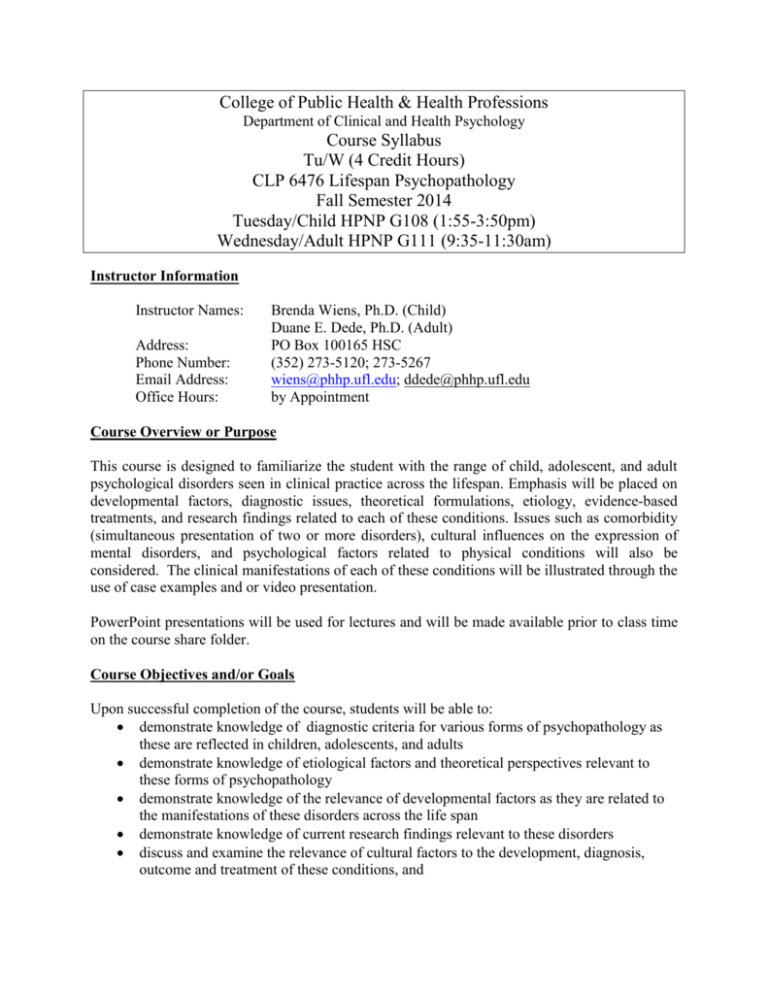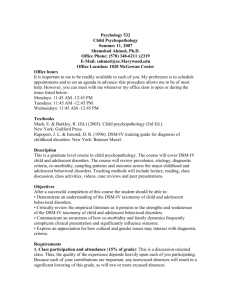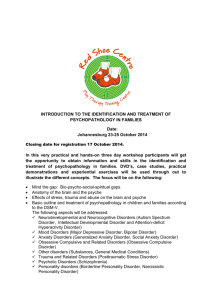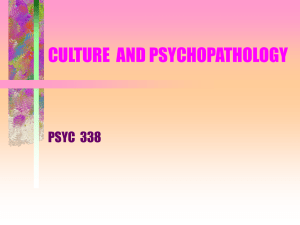sample course syllabus - Department of Clinical and Health
advertisement

College of Public Health & Health Professions Department of Clinical and Health Psychology Course Syllabus Tu/W (4 Credit Hours) CLP 6476 Lifespan Psychopathology Fall Semester 2014 Tuesday/Child HPNP G108 (1:55-3:50pm) Wednesday/Adult HPNP G111 (9:35-11:30am) Instructor Information Instructor Names: Address: Phone Number: Email Address: Office Hours: Brenda Wiens, Ph.D. (Child) Duane E. Dede, Ph.D. (Adult) PO Box 100165 HSC (352) 273-5120; 273-5267 wiens@phhp.ufl.edu; ddede@phhp.ufl.edu by Appointment Course Overview or Purpose This course is designed to familiarize the student with the range of child, adolescent, and adult psychological disorders seen in clinical practice across the lifespan. Emphasis will be placed on developmental factors, diagnostic issues, theoretical formulations, etiology, evidence-based treatments, and research findings related to each of these conditions. Issues such as comorbidity (simultaneous presentation of two or more disorders), cultural influences on the expression of mental disorders, and psychological factors related to physical conditions will also be considered. The clinical manifestations of each of these conditions will be illustrated through the use of case examples and or video presentation. PowerPoint presentations will be used for lectures and will be made available prior to class time on the course share folder. Course Objectives and/or Goals Upon successful completion of the course, students will be able to: demonstrate knowledge of diagnostic criteria for various forms of psychopathology as these are reflected in children, adolescents, and adults demonstrate knowledge of etiological factors and theoretical perspectives relevant to these forms of psychopathology demonstrate knowledge of the relevance of developmental factors as they are related to the manifestations of these disorders across the life span demonstrate knowledge of current research findings relevant to these disorders discuss and examine the relevance of cultural factors to the development, diagnosis, outcome and treatment of these conditions, and demonstrate knowledge of evidence-based assessments and treatments for the range of disorders considered. Class Format Over the course of the semester, each week the class will consist of one two-hour class dealing with various common forms of psychopathology as these are reflected in children and adolescents and a second two-hour class meeting focusing on various forms of psychopathology as they are reflected in adults of varying ages. Faculty members teaching the two sections of the class will be individuals with specific expertise in the areas of child/adolescent and adult psychopathology, respectively. Class format will consist of combinations of lectures, group discussions, presentation of clinical case material and demonstrations. In addition, adult psychopathology lectures will be supplemented by a “movie night” (attendance is optional but encouraged) which will include viewing and discussions of cinematic depiction of psychopathology and its social context. A list of movies has been identified and additional ideas will be solicited from participants. Both the child and adult psychopathology portion of the class will also require students to prepare a 30 minute presentation on topics that will be assigned during the first week of class. Attendance and active participation in class sessions is required. Course Materials Adult Related Readings The following texts are required and may be purchased in the HSC Bookstore: Sadock, B.J., Sadock, V. A., & Ruiz, P. (Eds.). (2014). Kaplan and Sadock’s Synopsis of Psychiatry (11th Ed.). New York: Williams & Wilkins. American Psychiatric Association. (2013). Diagnostic and Statistical Manual of Mental Disorders, Fifth Edition (DSM-5). Washington, D.C.: American Psychiatric Association. A listing of additional readings for the adult-focused portion of this course is provided in the Addendum to this syllabus. These readings can be found on the student share drive in a folder devoted to this course, labeled “Lifespan Psychopathology” (S:\CP-Student\LIFESPAN PSYCHOPATHOLOGY Fall 2014), under the heading of “Dede Readings.” These readings will include selected de-identified cases that will be discussed during listed weeks. Please also download the “iTunesU” app. Various podcasts will be discussed during the semester. Copies of the Powerpoint slides are also available within the LIFESPAN PSYCHOPATHOLOGY FALL 2014 folder. Child/Adolescent Related Readings The following texts are required and may be purchased in the HSC Bookstore: Beauchaine, T. P., & Hinshaw, S. P. (2013). Child and Adolescent Psychopathology, 2nd Edition. Hoboken, New Jersey: Wiley. (Kindle version available) 2 American Psychiatric Association. (2013). Diagnostic and Statistical Manual of Mental Disorders, Fifth Edition (DSM-5). Washington, D.C.: American Psychiatric Association. A listing of additional readings for the child/adolescent portion of this course is provided in the Addendum to this syllabus. These readings can be found on the student share drive in a folder devoted to this course, labeled “Lifespan Psychopathology” (S:\CP-Student\LIFESPAN PSYCHOPATHOLOGY Fall 2014), under the heading of “Wiens Readings.” Copies of the Powerpoint slides are also available within the LIFESPAN PSYCHOPATHOLOGY FALL 2014 folder. Course Requirements/Evaluation/Grading Grades will be based on the results of mid-term and final examinations, as well as class presentations, in both the adult and child sections of the course. Each of the four exams will be worth a total of 100 points (Total for the course = 400) and may consist of a mixture of short answer, listing/multiple-choice, and essay questions related to research relevant to various disorders, assessment, diagnostic, treatment, or other issues relevant to a lifespan conceptualization of psychopathology. Exams will be based on information from readings, case examples, classroom video presentations, lectures, and class discussion. Each of the two presentations will be worth a total of 100 points (Total for the course = 200); requirements for presentations will be discussed at the beginning of the course. Grades will be determined based on the average of scores obtained on the four exams and two class presentations in the adult and child sections of the class, using the following scale for determining grades: Grading Scale (in percentages) 93-100 = 4.0 (A) 90-92 = 3.67 (A-) 87-89 = 3.33 (B+) 83-86 = 3.00 (B) 80-82 = 2.67 (B-) 77-79 = 2.33 (C+) 73-76 = 2.00 (C) 70-72 = 1.67 (C-) 67-69 = 1.33 (D+) 63-66 = 1.00 (D) 60-62 = 0.67 (D-) 3 Tentative Outline of Topics Week 1 (August 26 and 27) Introduction – Development and Risk Factors in Psychopathology Introduction - Lifespan Issues in Psychopathology, Diagnosis and Classification of Psychological Disorders Week 2 (September 2 and 3) Overview of new DSM-5 Neurodevelopmental Disorders; Autism Spectrum Disorder Other Psychotic Disorders, Dissociative Disorders and Impulse-Control Disorders Week 3 (September 9 and 10) Autism Spectrum Disorder (Continued); Intellectual Disabilities Neurocognitive Disorders (Delirium, Dementia and other Cognitive Disorders) Week 4 (September 16 and 17) Attention-Deficit Hyperactivity Disorder in Childhood and Adolescence Anxiety Disorders in early, middle, and later adulthood* Week 5 (September 23 and 24) Attention-Deficit/Hyperactivity Disorder (continued); Tic Disorders; Specific Learning Disorders Substance-Related and Addictive Disorders Week 6 (September 30 and October 1) Oppositional Defiant Disorder, Conduct Disorder, and Juvenile Delinquency Schizophrenia Spectrum Week 7 (October 7 and 8) Elimination Disorders: Enuresis and Encopresis; (1 student presentation) (3 presentations) Week 8 (October 14 and 15) Mid-Term Exam (Wiens) Somatic Symptom and Related Disorders & Sleep-Wake Disorders 4 Week 9 (October 21 and 22) Childhood and Adolescent Mood Disorders Mid-Term Exam (Dede) Week 10 (October 28 and 29) Childhood and Adolescent Mood Disorders (Continued); Anxiety Disorders in Childhood and Adolescence Depressive, Bipolar and Related Disorders I Week 11 (November 4 and 5) Anxiety Disorders in Childhood and Adolescence (Continued); ObsessiveCompulsive Disorder in Childhood and Adolescence Depressive, Bipolar and Related Disorders (Continued) Week 12 (No Class 11/11 Veteran’s Day; November 12) Personality Disorders* Week 13 (November 18 and 19) Trauma and Stressor-Related Disorders in Childhood and Adolescence; (2 student presentations) Eating Disorders & Obsessive-Compulsive and Related DOs* (2 presentations) Week 14 (November 25; No Class 11/26 Thanksgiving) Adolescent Substance Use; Pediatric Psychology Week 15 (December 2 and 3) Student presentations (3) Student presentations (3-4) and review for final Week 16 (December 9 and 10) Cultural Competence and Mental Health Disparities in Clinical Child Psychology; review for final Final Exam - Adult Week 17 (December 16) Final Exam – Child –THE ROOM FOR THE FINAL WILL BE G-110 5 Statement of University’s Honesty Policy (cheating and use of copyrighted materials) Academic Integrity – Students are expected to act in accordance with the University of Florida policy on academic integrity (see Student Conduct Code, the Graduate Student Handbook or this web site for more details: www.dso.ufl.edu/judicial/procedures/academicguide.php). Cheating, lying, misrepresentation, or plagiarism in any form is unacceptable and inexcusable behavior. UF students are bound by The Honor Pledge which states, “We, the members of the University of Florida community, pledge to hold ourselves and our peers to the highest standards of honor and integrity by abiding by the Honor Code. On all work submitted for credit by students at the University of Florida, the following pledge is either required or implied: ‘On my honor, I have neither given nor received unauthorized aid in doing this assignment.’” The Honor Code (http://www.dso.ufl.edu/sccr/process/student-conduct-honor-code/) specifies a number of behaviors that are in violation of this code and the possible sanctions. Furthermore, you are obligated to report any condition that facilitates academic misconduct to appropriate personnel. If you have any questions or concerns, please consult with the instructors in this class. Policy Related to Class Attendance Attendance is expected as a part of the student’s professional training. Students are expected to arrive for class on time and to remain for the full class period. Students needing to miss class should make prior arrangements with the instructor. Classroom Etiquette Please refrain from using I-pods, cell phones or any other electronic devices during class as it is distracting and inconsiderate of other students and the instructor. Laptop use is acceptable for note taking or following slides. Please do not arrive late to class or disrupt the class as it is distracting and inconsiderate of other students and the instructor. To the extent permitted by facility rules and restrictions, you may bring food and/or beverages to class as long as it does not interfere with your ability to work and/or participate in class and as long as it does not interfere with or your classmates’ ability to work and participate in class. You will be expected to clean-up after yourself and dispose of all trash before leaving the classroom. Policy Related to Make-up Exams or Other Work Students who must miss an exam or paper deadline because of conflicting professional or personal commitment must make prior arrangements with the instructor. If an examination must be missed because of illness, a doctor’s note is required. “Requirements for class attendance and make-up exams, assignments, and other work in this course are consistent with university policies that can be found in the online catalog at: https://catalog.ufl.edu/ugrad/current/regulations/info/attendance.aspx.” 6 Statement Related to Accommodations for Students with Disabilities Accommodations for Students with Disabilities If you require classroom accommodation because of a disability, you must first register with the Dean of Students Office (http://oss.ufl.edu/). The Dean of Students Office will provide documentation to you, which you then give to the instructor when requesting accommodation. The College is committed to providing reasonable accommodations to assist students in their coursework. Counseling and Student Health Students may occasionally have personal issues that arise in the course of pursuing higher education or that may interfere with their academic performance. If you find yourself facing problems affecting your coursework, you are encouraged to talk with an instructor and to seek confidential assistance at the University of Florida Counseling Center, 352-392-1575, or Student Mental Health Services, 352-392-1171. Visit their web sites for more information: http://www.counseling.ufl.edu/cwc/Default.aspx. The Student Health Care Center at Shands is a satellite clinic of the main Student Health Care Center located on Fletcher Drive on campus. Student Health at Shands offers a variety of clinical services, including primary care, women's health care, immunizations, mental health care, and pharmacy services. The clinic is located on the second floor of the Dental Tower in the Health Science Center. For more information, contact the clinic at 392-0627 or check out the web site at: www.health.ufl.edu/shcc Crisis intervention is always available 24/7 from: Alachua County Crisis Center: (352) 2646789. For emergencies, you can call 911 or access the University of Florida Police by calling 392-1111. Posting of Syllabus The course syllabus will be posted in the course share folder and will be submitted to the departmental office to document compliance. Online Course Evaluation Students are expected to provide feedback on the quality of instruction in this course based on 10 criteria. These evaluations are conducted online at https://evaluations.ufl.edu. Evaluations are typically open during the last two or three weeks of the semester, but students will be given specific times when they are open. Summary results of these assessments are available to students at https://evaluations.ufl.edu/results/. 7 Addendum Required Adult Psychopathology Readings Introduction: Life Span issues in Psychopathology, Diagnosis and Classification – Week 1 Gottesman, I. (2001). Psychopathology through a life span-genetic prism. American Psychologist, 56 (11), 867 - 878. Achenbach, T.M. & Rescorla, L.A. (2006). Developmental issues in assessment, taxonomy, and diagnosis of psychopathology. In D. Chicchetti and D. Cohen (Eds.) Developmental Psychopathology, Volume 1: Theory and Method (2nd Edition), Hoboken, NJ, Wiley, 139 – 180. Youngstrom, E. (2008). Evidence-based strategies for the assessment of developmental psychopathology: measuring prediction, prescription, and process. In E.W. Craighead, D.J. Miklowitz, & L.W. Craighead (Eds.), Psychopathology: History, diagnosis, and empirical foundations. Hoboken, NJ: Wiley. Neurocognitive Disorders – Week 3 Collins, M., Grindell, S., Lovell, M.R., Dede, D.E, Moser, D.J., Phalin, B.R., Nogle, S., Wasik, M., Cordry, D., Daugherty, M.K., Sears, S.F., Nicolette, G., Indelicato, P. & McKeag., D.B. (1999) Relationship between concussion and neuropsychological performance in college football players. JAMA, 282: 964-970. Roman, G.C., Sachdev, P., Royal, D.R., Bullock, R.A., Orgogozo, J., Lopea-Pousa, S., Arizaga, R., and Wallin, A. (2004). Vascular cognitive disorder: a new diagnostic category updating vascular cognitive impairment and vascular dementia. Journal of Neurological Sciences, 226: 81-87. Satz, P. (1993). Brain reserve capacity on symptom onset after brain injury: A formulation and review of evidence for threshold theory. Neuropsychology, 7: 273-295. Substance-Related and Addictive Disorders - Week 5 Mintzer, M.Z., Copersino, M.L. and Stitzer, M.L. (2005). Opiod abuse and cognitive performance. Drug and Alcohol Dependence, 78: 225-230. Depressive and Bipolar Disorders – Weeks 10 and 11 Baune, B. T., Suslow, T., Arolt., V. and Berger, K. (2007). The relationship between psychological dimensions of depressive symptoms and cognitive functioning in the elderly: The MEMO-Study. Journal of Psychiatric Research, 41: 247-254. Miklowitz, D.J. and Cicchetti, D. (2006). Toward a life span developmental psychopathology perspective on bipolar disorder. Development and psychopathology, 18, 935 – 938. See “Tyson” PDF and de-identified report (July 2014) 8 Required Child/Adolescent Psychopathology Readings Development and Risk Factors in Psychopathology – August 26 Child and Adolescent Psychopathology – Chapters 3 (Genetic and Environmental Influences on Behavior, 4 (Risk and Resilience in Child and Adolescent Psychopathology), and 5 (Child Maltreatment and Risk for Psychopathology) Autism Spectrum Disorder and Intellectual Disabilities – September 2 & 9 DSM-5 section on Autism Spectrum Disorder (pages 50-59) Child and Adolescent Psychopathology – Chapter 20 (Autism Spectrum Disorders) Huerta, M., Bishop, S. L., Duncan, A., Hus, V., & Lord, C. (2012). Application of DSM-5 criteria for Autism Spectrum Disorder to three samples of children with DSM-IV diagnoses of Pervasive Developmental Disorders. American Journal of Psychiatry, 169, 1056-1064. McPartland, J. C., Reichow, B., & Volkmar, F. R. (2012). Sensitivity and specificity of proposed DSM-5 diagnostic criteria for Autism Spectrum Disorder. Journal of the American Academy of Child and Adolescent Psychiatry, 51, 368-383. Attention Deficit Hyperactivity Disorder – September 16 & 23 DSM-5 sections on ADHD (pages 59-66) Child and Adolescent Psychopathology – Chapter 12 (Attention-Deficit/Hyperactivity Disorder) Optional: Evans, S. W., Owens, J. S., & Bunford, N. (2014). Evidence-based psychosocial treatments for children and adolescents with Attention-Deficit/Hyperactivity Disorder. Journal of Clinical Child and Adolescent Psychology, 43, 527-551. Learning Disorders, Tic Disorders – September 23 DSM-5 sections Learning Disorders (pages 66 to 74), and Tic Disorders (pages 81-85) Fletcher, J. M., Francis, D. J., Morris, R. D., & Lyon, G. R. (2005). Evidence-based assessment of learning disabilities in children and adolescents. Journal of Clinical Child and Adolescent Psychology, 34, 506-522. Fletcher, J. M., & Vaughn, S. (2009). Response to intervention: Preventing and remediating academic difficulties. Child Development Perspectives, 3, 30-37. Oppositional Defiant/Conduct Disorder/Juvenile Delinquency – September 30 DSM-5 sections on ODD (pages 462-466) and CD (pages 469-476) Child and Adolescent Psychopathology – Chapter 13 (Oppositional Defiant Disorder, Conduct Disorder, and Juvenile Delinquency) 9 Optional: Loeber, R., Burke, J. D., & Pardini, D. A. (2009). Development and etiology of disruptive and delinquent behavior. Annual Review of Clinical Psychology, 5, 291-310. Eliminative Disorders: Enuresis and Encopresis – October 7 DSM-5 section on Elimination Disorders (355-360) Fritz, G., Rockney, R., et al. (2004). Summary of the practice parameters for the assessment and treatment of children and adolescents with enuresis. Journal of the American Academy of Child and Adolescent Psychiatry, 43, 123-125. Campbell, L. K., Cox, D. J., & Borowitz, S. M. (2009). Elimination Disorders: Enuresis and Encopresis. In M. C. Roberts & R. G. Steel (Eds). Handbook of Pediatric Psychology (4th Ed) (pp. 481-490). New York: Guilford Press. Child/Adolescent Mood Disorders – October 21 and 28 DSM-5 section on Disruptive Mood Dysregulation Disorder (pages 156-160); sections on Bipolar I and II disorders (pages 123-139), Major Depressive Disorder (pages 160-168), and Persistent Depressive Disorder (pages 168-171) Child and Adolescent Psychopathology – Chapters 17 (Depressive Disorders) and 19 (Bipolar Disorder) Copeland, W. E., Angold, A., Costello, E. J., & Egger, H. (2013). Prevalence, comorbidity, and correlates of DSM-5 proposed Disruptive Mood Dysregulation Disorder. American Journal of Psychiatry, 170, 173-179. Axelson, D. (2013). Editorial: Taking Disruptive Mood Dysregulation Disorder out for a test drive. American Journal of Psychiatry, 170, 136-139 Optional: Fristad, M. A., & MacPherson, H. A. (2014). Evidence-based psychosocial treatments for child and adolescent bipolar spectrum disorders. Journal of Clinical Child and Adolescent Psychology, 43, 339-355. Child/Adolescent Anxiety Disorders – October 28 & November 4 DSM-5 section on Anxiety Disorders (starts page 189, review Separation Anxiety Disorder, Selective Mutism, Specific Phobia, Social Anxiety Disorder, Generalized Anxiety Disorder) Child and Adolescent Psychopathology – Chapter 16 (Anxiety Disorders) Child/Adolescent OCD – November 4 DSM-5 section on OCD (pages 237-242) Geller et al. (2012). Practice parameter for the assessment and treatment of children and adolescents with Obsessive-Compulsive Disorder. Journal of the American Academy of Child and Adolescent Psychiatry, 51, 98-113. 10 Optional: Freeman, J., Garcia, A., Frank, H., Benito, K., Conelea, C., Walther, M., & Edmunds, J. (2014). Evidence base update for psychosocial treatments for pediatric obsessive-compulsive disorder, Journal of Clinical Child and Adolescent Psychology, 43, 7-26. Child/Adolescent Trauma and Stressor Disorders – November 18 DSM-5 section on PTSD (pages 271-280) Dyregrov, A., & Yule, W. (2006). A review of PTSD in children. Child and Adolescent Mental Health, 11, 176-184. Adolescent Substance Use; Overview of Pediatric Psychology – November 25 Child and Adolescent Psychopathology – Chapter 15 (Substance Use Disorders in Adolescence) Law, E. F., Fisher, E., Fales, J., Noel, M., & Eccleston, C. (2014). Systematic review and metaanalysis: Parent and family-based interventions for children and adolescents with chronic medical conditions. Journal of Pediatric Psychology. doi:10.1093/jpepsy/jsu032 Pai, A. L. H., & McGrady, M. (2014). Systematic review and meta-analysis of psychological interventions to promote treatment adherence in children, adolescents, and young adults with chronic illness. Journal of Pediatric Psychology. doi:10.1093/jpepsy/jsu038 Optional: Beale, I. L. (2006). Scholarly literature review: Efficacy of psychological interventions for Pediatric Chronic Illnesses. Journal of Pediatric Psychology, 31, 437-451 Optional: Hogue, A., Henderson, C. E., Ozechowski, T. J., & Robbins, M. S. (2014). Evidence base on outpatient behavioral treatments for adolescent substance use: Updates and recommendations 2007-2013. Journal of Clinical Child and Adolescent Psychology. doi:10.1080/15374416.2014.915550 Cultural Competence & Mental Health Disparities in Clinical Child Psychology – Dec 9 Ecklund, K., & Johnson, W. B. (2007). Toward cultural competence in child intake assessments. Professional Psychology: Research and Practice, 38, 356-362. Costello, E. J., He, J., Sampson, N. A., Kessler, R. C., & Merikangas, K. R. (2014). Services for adolescents with psychiatric disorders: 12-month data from the National Comorbidity SurveyAdolescent. Psychiatric Services, 65, 359-366. Kazak, A. E. (2010). A meta-systems approach to evidence-based practice for children and adolescents. American Psychologist, 65, 85-97. 11








